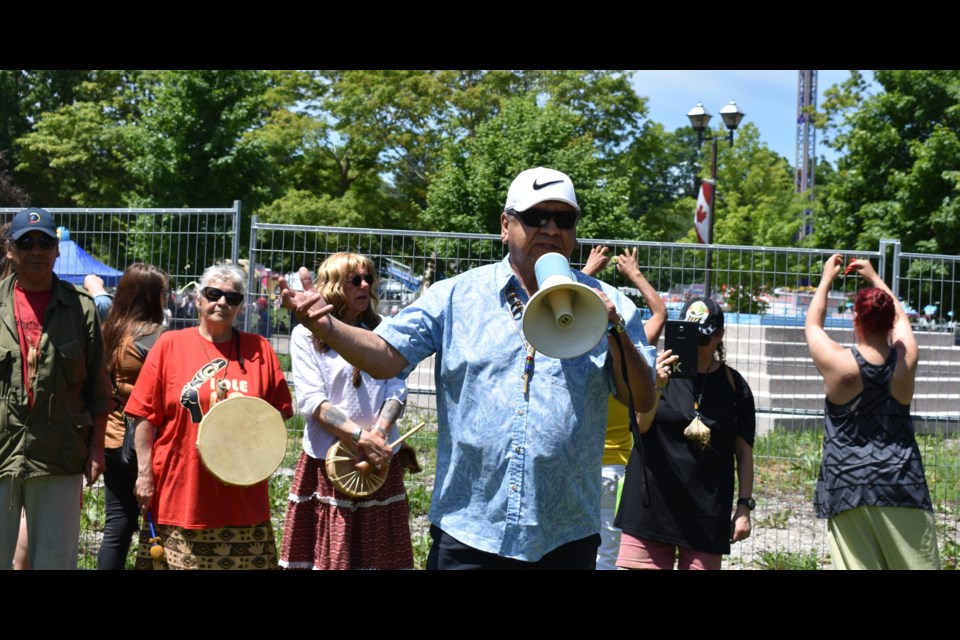ORILLIA - A group of about 50 people, with a mix of Indigenous and non-Indigenous people, staged a peaceful Canada Day protest Monday outside the fence encircling the space where the Champlain Monument once stood.
Erected in 1925, the bronze statue was removed two years ago for refurbishing. However, its owner, Parks Canada, put its return on hold after its removal sparked a storm of controversy about its portrayal of Indigenous people.
Last week, city council decided the monument should return in its original form with an “accompanying narrative that would more accurately reflect the complete history and context of the Champlain Monument.”
They also stressed work should continue with Indigenous groups to “explore additional strategies that would assist the community in helping move the national issue of reconciliation forward in a meaningful way.”
Ultimately, the decision rests with Parks Canada. However, local First Nations people are concerned about the direction things are going; it’s why they organized the protest.
“It can’t go up again,” Rama’s Emerson Nanigishkang said of the Champlain Monument, which he called a “racist monument.”
He reminded those congregated at the park that they were on land that was called The Narrows before it was Orillia.
“We lived over there,” he said, pointing to the west. “But we got kicked off here and Coldwater ... They gave us a bit of money and said, ‘Here, buy your own land.’ We have a lot of hurt.”
Jeff Monague, a well-respected First Nations educator and advocate, said he fears more hurt.
“I’ve talked to a few students,” said Monague, noting those pupils made their opinions known during the recent consultations conducted by the Champlain Monument Working Group.
“I’m afraid they’re feeling slapped in the face because none of their wishes are being heard here,” Monague said. “So, there’s another generation coming up and feeling stepped on and that’s what they are doing here. That’s why I’m here: To support them.
“I was hoping it would be a better outcome.”
Jack Payette echoed those sentiments. He talked about the relationship that was forged between Champlain and the Wendats who were here at that time in 1615.
“Champlain decided to stay here because he was injured and he stayed over the winter … and the chief took care of him and supplied him and his entourage,” said Payette.
“That’s not depicted on that monument,” he said, frustration evident. Rather, in the monument it appears as if the Indigenous men are “almost kissing his feet.”
He said the portrayal and placement of the Indigenous men, at Champlain’s feet, is not the right depiction.
“We have to change the image … (He) came across as superior. In fact, he was inferior at the time - he was being helped. He was learning about their hunting and fishing.”
Angela Cadieux said education is critical.
”Sometimes it’s hard for me to say I’m a proud Canadian. I want to be,” said Cadieux. “We need to know our history. We can’t change our history, but we can unite together and make it a better place for us all and our children. Let’s do it!”
While some of the protesters carried signs emblazoned with strong messages and pointed words, the participants were respectful and peaceful.
Several played drums and sang a protest song; they smudged and observed their timeless rites.
Participants were invited to tie a ribbon representing the four colours of First Nations directions to the fence encircling the plot where the monument had stood since 1925.
Clifford Perry, a relative newcomer to Orillia, felt drawn to the protest. He said the Idle No More movement several years ago first spurred him to action.
Perry said people “have been told stories our whole lives. It just makes me sick. I’m going to stand up for what I believe,” he said. “I spent decades being a couch observer. One day, I just said: ‘No more!’”
Horseshoe Valley’s Deb Brown agreed.
“I’ve been really thinking about this. Truth and reconciliation can only happen if we look at the truth,” she said.
“White people’s ancestors did not mean any harm, but we caused harm. To acknowledge that is important,” said Brown. “It’s an issue for all of us and I am pleased to speak for some white people about this.”
The future of the monument remains uncertain but Rosanne Irving, one of the organizers, remains hopeful.
She wants to see things “move forward through truth and reconciliation in a positive way.”
Irving said it’s vital to become educated.
“We need to understand the history - our Canadian history,” said Irving. “We need to understand that and move forward with that knowledge.”
- OrilliaMatters.com
